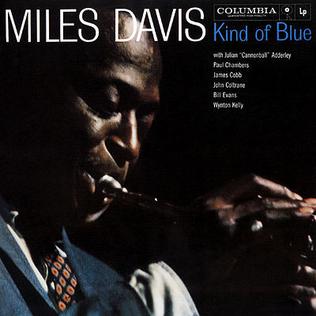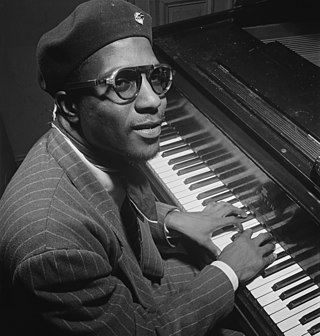Jazz is a music genre that originated in the African-American communities of New Orleans, Louisiana, in the late 19th and early 20th centuries, with its roots in blues, ragtime, European harmony and African rhythmic rituals. Since the 1920s Jazz Age, it has been recognized as a major form of musical expression in traditional and popular music. Jazz is characterized by swing and blue notes, complex chords, call and response vocals, polyrhythms and improvisation.

Kind of Blue is a studio album by the American jazz trumpeter and composer Miles Davis. It was released on August 17, 1959 through Columbia Records. For the recording, Davis led a sextet featuring saxophonists John Coltrane and Julian "Cannonball" Adderley, pianist Bill Evans, bassist Paul Chambers, and drummer Jimmy Cobb, with new band pianist Wynton Kelly appearing on one track – "Freddie Freeloader" – in place of Evans. The recording took place on March 2 and April 22, 1959 at Columbia's 30th Street Studio in New York City.

Miles Smiles is an album by the jazz musician Miles Davis. It was released on February 16, 1967 through Columbia Records. It was recorded by Davis and his second quintet at Columbia 30th Street Studio in New York City on October 24 and October 25, 1966. It is the second of six albums recorded by Davis' second great quintet, which featured tenor saxophonist Wayne Shorter, pianist Herbie Hancock, bassist Ron Carter, and drummer Tony Williams.

Jazz harmony is the theory and practice of how chords are used in jazz music. Jazz bears certain similarities to other practices in the tradition of Western harmony, such as many chord progressions, and the incorporation of the major and minor scales as a basis for chordal construction. In jazz, chords are often arranged vertically in major or minor thirds, although stacked fourths are also quite common. Also, jazz music tends to favor certain harmonic progressions and includes the addition of tensions, intervals such as 9ths, 11ths, and 13ths to chords. Additionally, scales unique to style are used as the basis of many harmonic elements found in jazz. Jazz harmony is notable for the use of seventh chords as the basic harmonic unit more often than triads, as in classical music. In the words of Robert Rawlins and Nor Eddine Bahha, "7th chords provide the building blocks of jazz harmony."

Jazz piano is a collective term for the techniques pianists use when playing jazz. The piano has been an integral part of the jazz idiom since its inception, in both solo and ensemble settings. Its role is multifaceted due largely to the instrument's combined melodic and harmonic capabilities. For this reason it is an important tool of jazz musicians and composers for teaching and learning jazz theory and set arrangement, regardless of their main instrument. By extension the phrase 'jazz piano' can refer to similar techniques on any keyboard instrument.

Porgy and Bess is a studio album by the jazz musician Miles Davis, released in March 1959 on Columbia Records. The album features arrangements by Davis and collaborator Gil Evans from George Gershwin's 1935 opera of the same name. The album was recorded in four sessions on July 22, July 29, August 4, and August 18, 1958, at Columbia's 30th Street Studio in New York City. It is the second collaboration between Davis and Evans and has garnered much critical acclaim since its release, being acknowledged by some music critics as the best of their collaborations. Jazz critics have regarded the album as historically important.
Pitch axis theory refers to a way of thinking about chord progressions and modes, that was heavily used and popularized by the guitarist Joe Satriani.
"Milestones" is a jazz composition written by Miles Davis. It appears on the album of the same name in 1958. It has since become a jazz standard. "Milestones" is the first example of Miles composing in a modal style and experimentation in this piece led to the writing of "So What" from the 1959 album Kind of Blue. The song's modes consist of G Dorian for 16 bars, A Aeolian for another 16 bars, and then back to G Dorian for the last eight bars, then the progression repeats.
"So What" is the first track on the 1959 album Kind of Blue by American trumpeter Miles Davis.
"Satin Doll" is a jazz standard written by Duke Ellington and Billy Strayhorn with lyrics by Johnny Mercer. Written in 1953, the song has been recorded by Ella Fitzgerald, 101 Strings, Terry Callier, and Nancy Wilson. Its chord progression is well known for its unusual use of chords and opening with a ii-V-I turnaround.
Post-bop is a jazz term with several possible definitions and usages. It has been variously defined as a musical period, a musical genre, a musical style, and a body of music, sometimes in different chronological periods, depending on the writer. Musicologist Barry Kernfeld wrote in The New Grove Dictionary of Music and Musicians that post-bop is "a vague term, used either stylistically or chronologically to describe any continuation or amalgamation of bop, modal jazz, and free jazz; its meaning sometimes extends into swing and earlier styles or into fusion and third-world styles."
"Blue in Green" is the third piece on Miles Davis' 1959 album Kind of Blue. One of two ballads on the recording, the melody of "Blue in Green" is modal, incorporating Dorian, Mixolydian, and Lydian modes. This is the only piece on the album on which alto saxophonist Cannonball Adderley sits out.

Coltrane is a studio album by the jazz saxophonist, bandleader, and composer John Coltrane. It was recorded in April and June 1962, and released in July of that year through Impulse! Records. At the time, it was overlooked by the music press, but has since come to be regarded as a significant recording in Coltrane's discography. When reissued on CD, it featured a Coltrane composition dedicated to his musical influence "Big Nick" Nicholas that the saxophonist recorded for his Duke Ellington collaboration Duke Ellington & John Coltrane (1963). The composition "Tunji" was written by Coltrane in dedication to the Nigerian drummer Babatunde Olatunji.

1958 Miles is a compilation album by American jazz musician Miles Davis, released in 1974 on CBS/Sony. Recording sessions for tracks that appear on the album took place on May 26, 1958, at Columbia's 30th Street Studio and September 9, 1958, at the Plaza Hotel in New York City. 1958 Miles consists of three songs featured on side two of the LP album Jazz Track, which was released in November 1959, one song from the same session not appearing in the album, and three recordings from Davis' live performance at the Plaza Hotel with his ensemble sextet. The recording date at 30th Street Studio served as the first documented session to feature pianist Bill Evans performing in Davis' group.
The chord-scale system is a method of matching, from a list of possible chords, a list of possible scales. The system has been widely used since the 1970s.
In the late 1960s, Latin jazz, combining rhythms from African and Latin American countries, often played on instruments such as conga, timbale, güiro, and claves, with jazz and classical harmonies played on typical jazz instruments broke through. There are two main varieties: Afro-Cuban jazz was played in the US right after the bebop period, while Brazilian jazz became more popular in the 1960s. Afro-Cuban jazz began as a movement in the mid-1950s as bebop musicians such as Dizzy Gillespie and Billy Taylor started Afro-Cuban bands influenced by such Cuban and Puerto Rican musicians as Xavier Cugat, Tito Puente, and Arturo Sandoval. Brazilian jazz such as bossa nova is derived from samba, with influences from jazz and other 20th-century classical and popular music styles. Bossa is generally moderately paced, with melodies sung in Portuguese or English. The style was pioneered by Brazilians João Gilberto and Antônio Carlos Jobim. The related term jazz-samba describes an adaptation of bossa nova compositions to the jazz idiom by American performers such as Stan Getz and Charlie Byrd.

The Lydian Chromatic Concept of Tonal Organization is a 1953 jazz music theory book written by George Russell. The book is the founding text of the Lydian Chromatic Concept (LCC), or Lydian Chromatic Theory (LCT). Russell's work postulates that all music is based on the tonal gravity of the Lydian mode.
"Peace Piece" is a jazz piece recorded by Bill Evans in December 1958 for his album Everybody Digs Bill Evans. It is a pastoral improvisation done at the end of the recording session and is one of his simplest, built on a gentle Cmaj7 to G9sus4 two-chord progression that Evans had used earlier during the session for his version of "Some Other Time" from Leonard Bernstein's musical On the Town. It also reappeared in the opening to "Flamenco Sketches", which Evans recorded with Miles Davis the following year on the album Kind of Blue; Davis had taken a liking to the piece and wanted to reuse it.
"Glass Enclosure" is a composition by jazz pianist Bud Powell. The first recording was Powell's version for Blue Note Records in 1953, which was released as part of the album The Amazing Bud Powell, Vol. 2 the following year. It was also released as one side of a single, with "I Want to Be Happy".








